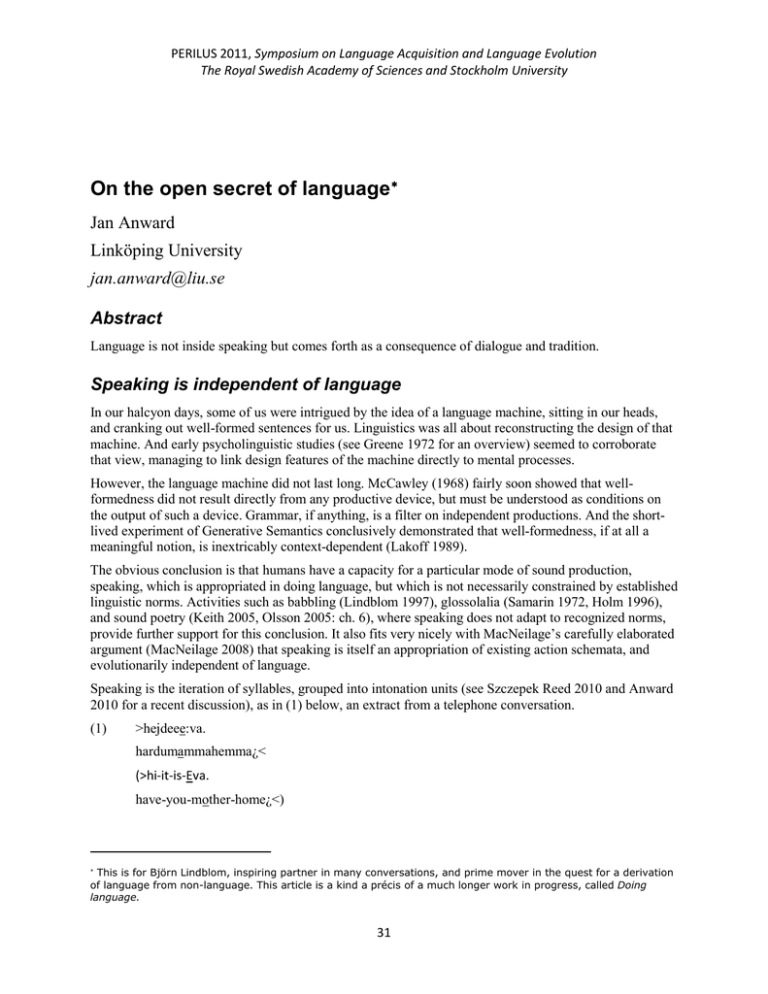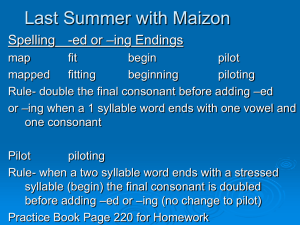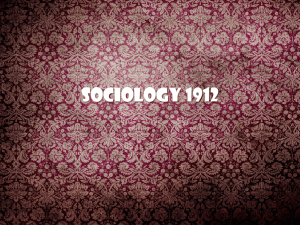
PERILUS 2011, Symposium on Language Acquisition and Language Evolution
The Royal Swedish Academy of Sciences and Stockholm University
Jan Anward –
On the open secret of language ∗
Jan Anward
Linköping University
jan.anward@liu.se
Abstract
Language is not inside speaking but comes forth as a consequence of dialogue and tradition.
Speaking is independent of language
In our halcyon days, some of us were intrigued by the idea of a language machine, sitting in our heads,
and cranking out well-formed sentences for us. Linguistics was all about reconstructing the design of that
machine. And early psycholinguistic studies (see Greene 1972 for an overview) seemed to corroborate
that view, managing to link design features of the machine directly to mental processes.
However, the language machine did not last long. McCawley (1968) fairly soon showed that wellformedness did not result directly from any productive device, but must be understood as conditions on
the output of such a device. Grammar, if anything, is a filter on independent productions. And the shortlived experiment of Generative Semantics conclusively demonstrated that well-formedness, if at all a
meaningful notion, is inextricably context-dependent (Lakoff 1989).
The obvious conclusion is that humans have a capacity for a particular mode of sound production,
speaking, which is appropriated in doing language, but which is not necessarily constrained by established
linguistic norms. Activities such as babbling (Lindblom 1997), glossolalia (Samarin 1972, Holm 1996),
and sound poetry (Keith 2005, Olsson 2005: ch. 6), where speaking does not adapt to recognized norms,
provide further support for this conclusion. It also fits very nicely with MacNeilage’s carefully elaborated
argument (MacNeilage 2008) that speaking is itself an appropriation of existing action schemata, and
evolutionarily independent of language.
Speaking is the iteration of syllables, grouped into intonation units (see Szczepek Reed 2010 and Anward
2010 for a recent discussion), as in (1) below, an extract from a telephone conversation.
(1)
>hejdeee:va.
hardumammahemma¿<
(>hi-it-is-Eva.
have-you-mother-home¿<)
This is for Björn Lindblom, inspiring partner in many conversations, and prime mover in the quest for a derivation
of language from non-language. This article is a kind a précis of a much longer work in progress, called Doing
language.
∗
31
Jan Anward
In the first line of (1), there are five syllables. One of these, the fourth one, is carrying pitch accent
(marked by underlining) and they are bound together by a falling intonation contour (marked by the final
period). In the second line, there are six syllables, a pitch accent, and a slightly rising intonation contour
(marked by the final inverted question mark).
Language comes from dialogue
So where does language come from? A language, a langue in a modified Saussurean sense (Saussure
1916, particularly ch. 4), is a regular outcome of conversation. Conversation is grounded in a natural
attitude of humans, a dialogical attitude (Linell 2009), which compels humans to hear a sound as an
address and an aboutness, to answer an address with a returned address and a continued aboutness, and to
assume that other humans work in the same way as you do.
Participants informed by a dialogical attitude will accomplish activities where they take turns at
connected dialogical actions, and where each action is relevant to the one preceding it, and anticipates a
relevant action following it. And these dialogical actions serve to update an ongoing social activity, by
introducing into it and maintaining there participants and relations among them. Some of these
participants and relations are physically present in the activity ('real'), while others are only symbolically
present, i.e. they enter and remain in the activity only through linguistic expression.
The result is a conversation, or a dialogue, as in (2), which is the opening of a land-line phone call
(recorded by Anna Lindström; see Lindström 1994). Eva calls a neighbour in a practical matter. Bodil, a
young girl who is visiting the neighbours' house to play with their daughter Veronika, answers the phone.
(2) Pippiperuk 1, opening
00
((fyra signaler))
01
Bodil:
>sexsjutvåfyra¿<
02
Eva:
>hejdeee:va.
03
04
hardumammahemma¿<
Bodil:
näe:.
(00
((four signals))
01
Bodil:
>six-seven-two-four¿<
02
Eva:
>hi-it-is-Eva.
03
04
have-you-mother-home¿<)
Bodil:
noo:.)
The first two turns of (2) is a classical example of an adjacency pair (Schegloff & Sacks 1973, Schegloff
2007), where, in the analysis of Schegloff (1968), a first action, a summons (line 00), makes a second
action, an answer (line 01), relevant, and where the pair as a whole makes further talk (line 02) relevant.
The answer to the summons is not just any answer, though, but an identification, which is accomplished
through recital of a telephone number, and this identification, in its turn, makes a second identification
relevant. The second identification, by first name this time, follows in the third turn (line 02), and it is
preceded by a greeting, which makes a second greeting relevant. However, Eva does not wait for a second
greeting. Instead, she asks Bodil to pass on the phone call to an adult, thereby deferring the second
greeting by means of an inserted question.
32
On the open secret of language
In accomplishing this small stretch of interaction, Eva and Bodil also do a small langue. Their unfolding
responsory of dialogical actions simultaneously unfolds a system of syntagmatically related turns, where
each turn is demarcated by a change in voice.
The ensuing system looks like this:
((fyra signaler))
summons
Bodil:
>(sexsjutvåfyra)¿<
answer
Eva:
>hejdeee:va.
identification
identification greeting
question
hardumammahemma¿<
Bodil:
answer
näe:.
In this way, by taking turns at dialogical actions, participants continuously structure their ongoing
conversation like a language (to borrow a formulation from Lacan 1977).
And from tradition
And when participants speak in a tradition, that is, model new conversations on old ones, they provide
their conversations with further structuration.
After the phone call, whose opening we saw in (2), Eva makes two more calls, to two other neighbours.
The openings of these calls follow in (3) and (4).
(3) Pippiperuk 2, opening
00 ((två signaler))
01
Karin:
två noll noll sju två¿
02
Eva:
ja hejsan de va >eva andersson<,
03
04
(0.3)
Karin:
m[hm¿
(00 ((two signals))
01
Karin:
two zero zero seven two¿
02
Eva:
yes hi-san it was >Eva Andersson<,
03
04
(0.3)
Karin:
m[hm¿)
(4) Flintskalleperuk, opening
00 ((två signaler))
01
Sylvia:
sylvia¿hh
02
Eva:
ja hejsan de va >eva andersson:<
03
Sylvia:
ja hej:
(00 ((two signals))
01
Sylvia:
Sylvia¿hh
02
Eva:
yes hi-san it was >Eva Andersson:<
33
Jan Anward
03
Sylvia:
yes hi:)
It is plain to see that (3) and (4) are versions of (2).
In all three cases, a summons (line 00) is followed by an answer, which is also a first identification (line
01). Then comes a first greeting, followed by a second identification (line 02). And then in (3), like in (2),
the second greeting which is made relevant by the first greeting does not directly come forth, but in (4), it
does.
But there are also differences between the two openings. The third turn of Pippiperuk 1 consists of two
intonation units:
hejdeee:va.
and
hardumammahemma¿<
Through her first intonation unit, Eva accomplishes a first greeting and a second identification. Through
her second intonation unit, she cancels the relevance of a second greeting by her current interlocutor.
In constructing the third turn of Pippiperuk 2, Eva uses only one intonation unit:
jahejsandeva>evaandersson<,
Again, she does a first greeting and a second identification, but this time she does not cancel the relevance
of a second greeting. This time, Eva is not talking to a child, who she does not want to talk to, she is
talking to another adult, a neighbour who not necessarily will recognize her (and in fact does not at first)
and who she does want to talk to.
This difference in social relations between the two contexts is indexed by formal differences between the
two turns: a more elaborated first greeting, where ja (yes) and the suffix san 1 are added to hej (hi), and a
more formal second introduction, which includes both Eva's first name and her last name, and where the
tense is changed, from present (e; is) to past (va; was).
The opening of Flintskalleperuk is cast in the same mold, and differs from that of Pippiperuk 2 only in the
placement of the pitch accent in the third turn - and, in the occurrence of a second greeting.
Thus, the openings of these three phone calls resonate 2 with each other, in that their articulations into
turns and intonation units match quite closely. When we align recurrent, i.e. formally and functionally
similar, units vertically, in a diagraph format (Du Bois 2004), we see how the openings through this
resonance are integrated into one system, where a further dimension of difference, Jakobsons's axis of
selection (Jakobson 1956: 60), comes into play. This is shown in (5) below.
Dialogical actions are indicated in abbreviated form (a = answer, g = greeting, i = identification, q =
question, r = reaction, s = summons).
1 The suffix san is derived from the parenthetical sa'n 'said-he', and now serves to strengthen certain interjections.
2 For this notion of resonance, see Anward & Lindblom 1999: 14, 27, and 37, and Du Bois 2004.
34
On the open secret of language
(5) Pippiperuk 1, Pippiperuk 2, and Flintskalleperuk, openings integrated
s
((fyra signaler))
ai
B: >(sexsjutvåfyra)¿<
E: >hejdeee:va.
hardumammahemma¿<
B: näe:.
a
s
((två signaler))
K:
ig
q
ai
tvånollnollsjutvå¿
E: jahejsandevaevaandersson,
(0.3) K: mhm¿
ig
r
s
((två signaler))
ai
S: sylvia¿hh
E: jahejsandevaevaandersson:
S: jahej
ig
g
Any such diagraph can be interpreted as a langue, that is, a network, or system, of syntagmatically,
paradigmatically, and associatively3 related units. Relations of temporal precedence translate
straightforwardly into syntagmatic relations, and vertically aligned items are paradigmatically related.
The resonance of the openings also affords further articulation of them, through the application of the
following principle, the fundamental ‘discovery procedure’ of structural linguistics (see e.g. Gleason
1961, chs. 5-7; and also Peters 1983: 37, and Anward & Lindblom 1999: 28).
(6) Segmentation
A turn which contains a recurrent part is articulated into that part, a preceding environment, and a
following environment.
The recurrent items två and sju articulate the second turns of (2) and (3) into sex två sju fyra and två
nollnoll sju två, and the recurrent items hej, de and eva articulate the third turns of (2), (3), and (4) into
hej de e eva hardumammahemma and ja hej san de va eva andersson.
3 Associative relations, relations of similarity, in form or meaning, are the system-defining relations introduced by Saussure (1916 [1967]: 170-175) alongside syntagmatic
relations. Hjelmslev (1959: 152) proposed to substitute paradigmatic relations for associative relations, but in fact, all three types of relation capture essential features of
conversational practice.
35
Jan Anward
And then we arrive at the langue in (7).
(7) Pippiperuk 1, Pippiperuk 2, and Flintskalleperuk, openings integrated
s
((fyra signaler))
ai
B: >(sex sju två fyra)¿<
E: >hej de e e:va.
hardumammahemma¿<
B: näe:.
a
s
((två signaler))
K:
ig
q
ai
två nollnoll sju två¿
E: ja hej san de va eva andersson,
(0.3) K: mhm¿
ig
r
s
((två signaler))
ai
S: sylvia¿hh
E: ja hej san de va eva andersson:
S: ja hej
ig
g
By taking turns at dialogical actions, and by modelling new conversations on old conversations,
participants continuously structure their conversations like a language, along the axes of combination and
selection, and down to the level of words and phrases.
36
On the open secret of language
References
Anward, J. (2010). Making units: Comments on Beatrice Szczepek Reed “Intonation phrases in natural
conversation: A participants’ category?”. Barth-Weingarten, D. et al. (eds.). Prosody in interaction.
Benjamins. 213-216.
Anward, J. & Lindblom, B. (1999). On the rapid perceptual processing of speech: From signal
information to phonetic and grammatical knowledge. http://www.liu.se/ikk/medarbetare/jananward/filarkiv-publikationer/1.209284/ja-1999b-anward-lindblom.pdf
Du Bois, J. W. (2004). Towards a Dialogic Syntax. Ms.
Gleason, H. A. (1961). An Introduction to Descriptive Linguistics. Holt, Rinehart & Winston.
Greene, J. (1972). Psycholinguistics. Chomsky and Psychology. Penguin.
Hjelmslev, Louis, 1959: Essais linguistiques. Travaux de Cercle Linguistique de Copenhague XII.
Holm, N. G. (1996). Extas, trans och tungotal. Cullberg, J. et al. (eds.). Mänskliga gränsområden. Natur
och kultur. 35-59.
Jakobson, R. (1956). Two aspects of language and two types of aphasic disturbances. Jakobson, R. &
Halle, M. Fundamentals of language. Mouton & Co.
Keith, Th. (2005). Poetische Experimente der deutschen und russischen Avantgarde (1912-1922) – ein
Vergleich. Weidler.
Lakoff, R. (1989). The way we were; or; the real actual truth about generative semantics: a memoir.
Journal of Pragmatics 13. 939-988.
Lindblom, B. (1997). Talet tar form. De Geer, B. et al. (eds.). Från joller till läsning. Gleerups. 11-32.
Lindström, A. (1994). Language as social action. Skrifter utgivna av Institutionen för nordiska vid
Uppsala universitet 46.
Linell, P. (2009). Rethinking language, mind, and world dialogically. Information Age Publishers.
MacNeilage, P. F. (2008). The Origin of Speech. Oxford University Press.
McCawley, J.D. (1968). Concerning the Base Component of a Transformational Grammar. Foundations
of Language 4. 243-269.
Olsson, J. (2005). Alfabetets användning: konkret poesi och poetisk artefaktion i svenskt 1960-tal. OEI
editör.
Peters, A. M. (1983). The Units of Language Acquisition. Cambridge University Press.
Samarin, W. J. (1972). Tongues of men and angels: the religious language of pentecostalism. Macmillan.
Saussure, F. de (1916). Cours de linguistique générale. Payot.
Schegloff, E. A. (1968). Sequencing in Conversational Openings. American Anthropologist 70. 10751095.
Schegloff, E. A. & Sacks, H. (1973). Opening Up Closings. SemioticaVIII. 289-327.
Schegloff, E. A. (2007). Sequence organization in interaction. Cambridge University Press.
Szczepek Reed, B. (2010). Intonation phrases in natural conversation: A participants’ category? BarthWeingarten, D. et al. (eds.). Prosody in interaction. Benjamins. 191-212.
37









